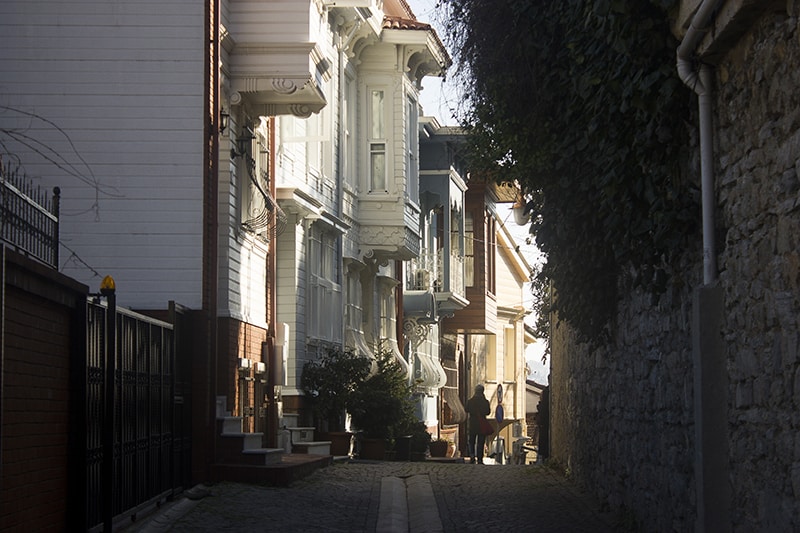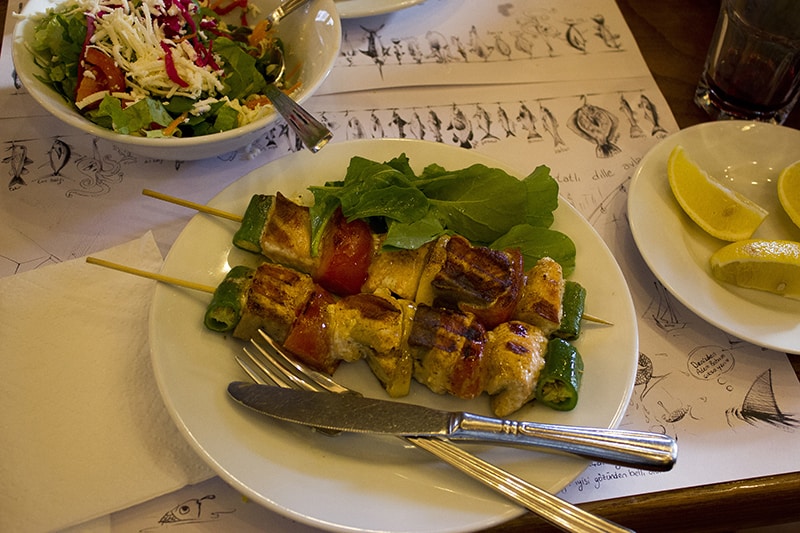Every once in a while, you come across a place that feels like a home away from home. As an expat, this feeling can be especially rare. Yet in Istanbul, I have found one unique neighborhood – Arnavutköy – that I keep returning to time and time again; something keeps drawing me back. Surrounded by nineteenth-century Ottoman wooden mansions, fragrant pine trees, and purple Erguvan blossoms, it’s easy to lose yourself in the midst of chaotic Istanbul. Arnavutköy, or the “Albanian Village”, is one of the most charming and historically significant Bosphorus neighborhoods. Tucked away in between Bebek and Kuruçeşme, it is a quiet, little multicultural retreat where you can find the most delicious fish restaurants, most breathtaking views and a little piece of Greek heritage still hanging around.

Arnavutköy was first settled by Greek fishermen in the Byzantine period. Known then as Hestai, then Promotu and Anaplus, the name we now know was given in the fifteenth century soon after Mehmed II conquered Constantinople. As part of a larger reshuffling of populations, Mehmed II relocated a community of Albanians to the area in order to increase the population. Over the course of the Ottoman empire, Arnavutköy attracted many different ethnic groups and cultures; a number of Jewish and Armenian families went to live there as well. It is said that in this unique village, where churches, synagogues, and mosques coexisted, there was an atmosphere of tolerance and a sense of community between the villagers.
At the turn of the century, Arnavutköy’s population was about 80% Greek with the rest made up of Jews, Armenians, and Turks. However, these days only a small community of Greeks remain. Devastating fires are one of many reasons for the change in population. One fire in 1798 burned all of the waterside residences, which were mostly owned by Greeks. Another fire in 1877 also left many Greek and Jewish families without homes and burned a number of shops as well. After the 1877 fire, most of the Jewish families immigrated to other countries. In the twentieth century, the Greek population continued to decrease due to tensions regarding Cyprus. Finally, the events of 6-7 September 1955 resulted in most Greek families leaving the country, although many had been born and raised in Istanbul. Furthermore, a large number of homes and shops owned by Greeks in Arnavutköy were looted and damaged during the riots. The homes of these departing families were then sold at low prices and the neighborhood was slowly repopulated with Turks.

The wooden houses are the main attraction of this beautiful area. While most of Istanbul’s houses are brick or concrete, a little piece of history has been preserved here. Along the Bosphorus shore is a row of wooden mansions called yalı. These yalı were historically used as summer resorts by the Ottoman elite. Many mansions further inland have also been renovated into multi-family homes and apartments. Built into the steep hills, each home is guaranteed a spectacular view of the blue straight and over to the Asian hills. Each home has its own personality, with ornate balconies, decorated door frames, and interesting roof embellishments. A number of them are painted in an assortment of pastels.
The natural environment of Arnavutköy also has a special history of its own. Lush rolling hills of green pines and purple blossoms framed by the blues of the sea and sky have provided livelihood for fishermen and farmers as well as inspiration to painters, writers and a plethora of other artists. The famous Erguvan, or Judas tree, blooms around the latter half of April and signifies the arrival of spring. It produces a brilliant pinkish-purple blossom. Erguvan has inspired many artists of Istanbul and even inspired the color of the new city buses. It was also the color of the Byzantine royal family and could only be worn by the aristocracy.

Arnavutköy is also known for its special variety of strawberry, called the Ottoman strawberry. They are smaller and less sweet than the regular variety but are very fragrant. The smell used to fill the streets during spring. Some strawberry fields are still alive today, hidden inside the backstreets of the neighborhood, and strawberry lovers flock to the markets during harvest season.
Arriving at Arnavutköy, you’ll notice the seaside mansions first. Take a walk up the shore towards Kuruçeşme before entering the village and pick which house you’ll live in one day (but not that one, that one’s mine.) Notice the giant red yalı, it’s the oldest in the area built between 1820 and 1830. It was owned by recently deceased Halet Çambel, famous archaeologist and also the first Muslim woman to compete in the Olympics. Head back to the interesting Atatürk statue next to Tevfikiye Mosque, which was built in 1832 in the neoclassical style. Also nearby is one of two Greek churches, both built in the late nineteenth century. First is Taksiarkes church, dedicated to the Archangels Michael and Gabriel. The second church, Profitis Elias, is in the upper part of the village. They are lovely buildings and should not be missed.

Wander up and down the steep, narrow streets for a bit, get lost but pay special attention to the personality of the area. Don’t forget to turn around every once in a while to take in the views. Once you’re hungry, head over to Adem Baba for a fish feast. Try their special fish soup that’s only served on Sundays and sells out quickly. Most likely, you’ll have to fight with the after church crowd for a table. Another option is Hayri, just around the corner from Adem Baba. With just a few tables, you’ll get a different type of service from Hayri, the owner. He’ll tell you what was caught fresh that day and serve it up with an ice cold draft beer. For an authentic Greek experience, head up to Neşemore Greek Tavern. Here you’ll find traditional live Greek music and authentic food.
Although the residents have changed over the years, the love for this neighborhood is very much alive today. There were talks in the early 2000s of building the third bridge through Arnavutköy. The residents formed a local initiative group to speak out about this proposed construction and to save their neighborhood. Although bittersweet, considering the alternative bridge location, Arnavutköy’s architectural and cultural heritage has been preserved for the time being. This neighborhood is a must-see for residents and tourists alike. Trust me, your visitors will be grateful for taking them somewhere unique and off the beaten path.
Editor’s Note: This post was originally published in February of 2014. It was updated for relevance on December of 2018.
Photo Credit: Merve Semsar


























I love Arnavütköy 🙂 You forgot to share also Ali Baba Köfte ( The best one in Istanbul ) and also Girandola ( The Best Ice Cream ) .
I love Arnavütköy 🙂 You forgot to share also Ali Baba Köfte ( The best one in Istanbul ) and also Girandola ( The Best Ice Cream ) .
It is my place 😉
I think you just added one more place in the world that I want to see!
Arnavutkoy is my “other home” and has been since late 1999 on my first visit when I was seduced by this extraordinary and charming village. Exotic, enticing, yet comfortable and familiar — this slice of paradise will be where I retire someday soon. 😉
my hometown…..
my hometown…..
Ja, geauso isses, ich war da ja 10 Jahre happy